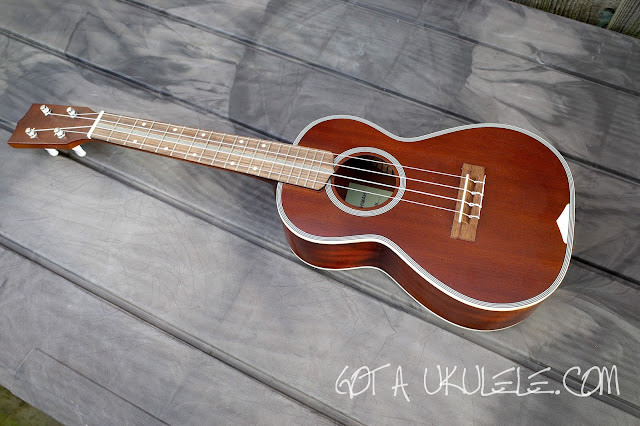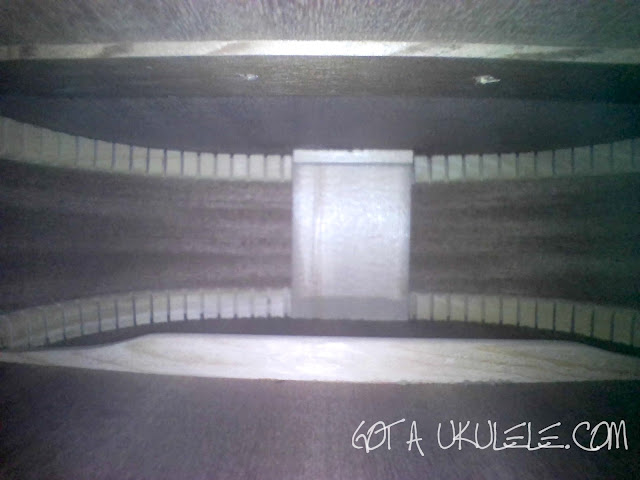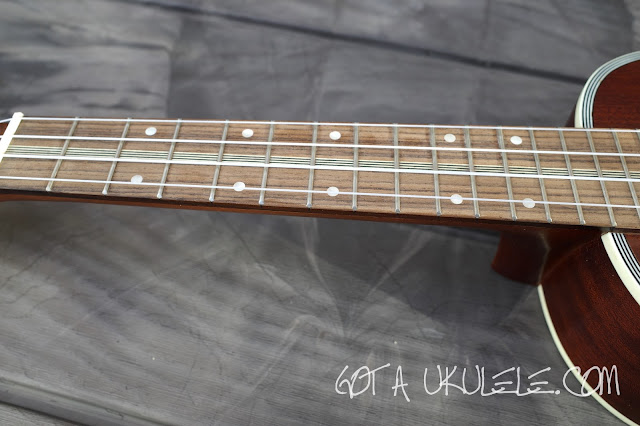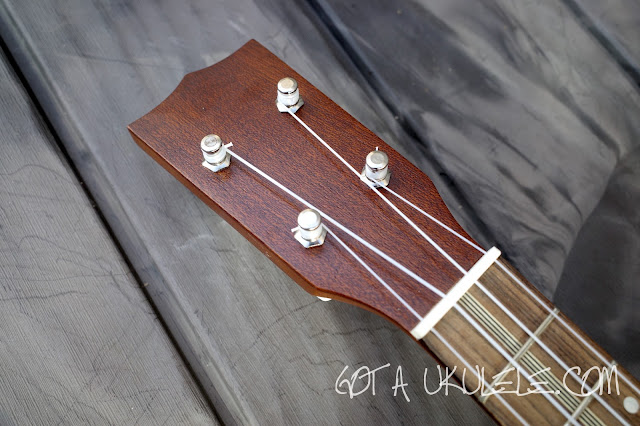It's a first appearance for this brand on Got A Ukulele. This week I look at the Mahimahi MC-3M Concert.
Mahimahi are an Italian brand based in Vicenza. They were actually developed as a 'house brand' for the Mercantino dell'ukulele store in Caldogno, itself a venture set up by the Aquila string company which you will all know very well. These are not built in Italy rather are far eastern instruments for the store to carry under their own name. There's no questioning the ukulele connection with a brand like Aquila involved but whether they live up to the name we shall see. And it should also be noted that whilst they are a house brand, they are also available in other shops around Europe. Sorry none EU readers - it's unlikely you will see these on your shores - but considering Got A Ukulele has mainly dealt with US and UK brands for years I suppose it's only fair that another region gets some representation.
If the MC-3M looks familiar, it's because it's based on the original 3M ukuleles first made by Martin decades ago. And Mahimahi are not the only brand to try to re-create one, Kiwaya did with the KTS-7 Soprano and so did Ohana with the SK-39. In fact Ohana also make a concert version called the CK-39 which is strikingly similar to this one in looks and finish. Incidentally, Mahimahi also make this in soprano and tenor scales too.
The body here is made from all solid mahogany in the top and back which are in pairs and also in the single piece sides. It's plain mahogany though nice and deep brown, and with the 3M stylings it's all about the decoration here. Plain as the wood is, it's nice and even in colour and looks just fine.
The bridge is a rosewood tie bar fitted with a straight topped bone saddle. It's tidy and I have no real complaints with the bridge itself functionally, but I really would have preferred a slot style bridge to be in keeping with the Martin models. Whilst the Ohana version also uses a tie bar the Martins, even in concert scale used a slot bridge. Spacing here is a quite narrow 38mm.
And then we come on to the decoration which is more 'in line with' the Martin styles rather than a direct replica. Around the top and back edges is white / cream binding and on the top this is paired with black and white purfling strips. Unlike the more usual couple of strips that you see on the back here, the top goes with four of them. If you think that is excessive, that's precisely what the Martin ukes had and is the core of the theme of the style. Around the soundhole are more rings and plenty of them - again, like the Martin. At the tail is what is called a 'Parend' or 'Pentaloque' inlay which is similar to the Martin in that it is 'there' but the shape is wrong for me. These inlays on the Martins are in a moustache shape that is designed to match the end shaping of the fingerboard. Here the end of the fingerboard is moustache shaped but the Parend is not not. It's hardly a huge criticism, but I think if you are going to do it, then do it right? My only other gripe is that the inlays and bindings here whilst not being snow white are less cream than I would like and look quite stark against the brown wood. Very much a subjective view of course, but there you are. The whole body is then finished in an open pore satin which isn't pooled or heavy in any area and feels nice on the hands. I would say though, like a lot of Ohana and Kala solid wood instruments of this price the finish feels more 'factory' than 'luthier' if that makes sense.
Inside is very tidy with notched linings, thin braces and no mess at all. The top is also pleasingly thin making for what I suspect is a resonant light build.
The neck is not specified, but I suspect is made from mahogany. There are joints at the heel an headstock, but both are hard to spot and the wood colours match. It tapers to average 35mm nut width with string spacing of 28mm G to A. That's not for me, but I will say that the profile, whilst not flat and shallow is not a broom-handle either. I could get by on this to be honest. I also quite like the exaggerated shape of the heel.
That is topped with a rosewood fingerboard which contains the rest of the decor embellishments that make the '3M style'. It's in good condition, but I think the wood on this example is too pale and, in fact, I wonder if it's actually a different wood to the spec (like Ovangkol or walnut). I'd much prefer a much darker board to make the inlays really stand out. As I say above it ends with the usual Martin style moustache end shape. It's fitted with 18 frets joined at the 14th and whilst it's not edge bound there is staining to hide the end. I can't feel than any of them are sharp. For inlays we have the Martin-esque black and white purfling stripes running right down the middle. They've gone with double dot position markers rather than small diamonds or snowflakes like many Martins. That's fine with me, but I'm not convinced you need one at the third! Other markers are at the 5th, 7th, 10th and 12th. Sadly, there are no side dots. That's an omission that irritates.
The nut is bone and beyond that is a Martin style crown headstock (it had to be) faced in a slightly darker mahogany. There is no brand logo on the front or, indeed, anything at all. I think it needs something here. Not all Martin 3M's had an inlay here, but I still think it looks bare and needs something.
Flipping it over and you see the 'logo' of Mahimahi - a dolphin. It's interesting to note that Mahimahi say on their site that they started using a dolphin because they admit they made a mistake in translation. A Mahi-Mahi is a Dolphinfish, and that is not a Dolphin. Ah well, at least they admitted it. Sorry to say though, I'm not a fan of the logo myself and wonder whether they thought the same and that's why it's on the back! The tuners are not named but I am sure they are standard Gotoh friction pegs. That's ok with me as whilst they are not the best friction pegs in the world, they work and are easily upgraded. They are a bit juddery to use like most entry level friction pegs so if you have an aversion you'd do well to assume you are going to upgrade them.
Completing the deal are a set of Aquila strings (I mean, what else - the store is owned by Aquila!) and they have an RRP of a little over €300. Browsing around I see them in EU stores for around €280. Whilst a straight currency conversion is misleading as it wouldn't include UK tax, with tax it takes it back to parity with the pound. That's a similar price to the Ohana CK-39 so on that basis the pricing seems about right. Bear in mind if you wanted a recent Martin 3M concert you would be going down the custom shop route and spending about $4000!
All in all my gripes here are not really life and death and the core build and finish feel very good and re-assuring. I suspect it is probably from the same factory line as something like the Ohana, but then Ohana don't have a moratorium on uke production. It's a similar price so that means alternative choice. I rather like looking at it and it feels nice. It's really light at only 420g and balances well too.
Basics first. The setup here is just fine for my tastes and it feels nice to play. The volume is extremely good, no doubt helped by that delicate top and you will have no worries being heard. The sustain and resonance is also decent and you can really feel the back vibrations when you play it. These things bode well.
Tone wise I am aware that my memory of the Ohana SK-39 was that it was a little tubby sounding for a soprano and wondered if it was down to the Aquila strings. It's the same strings here of course, but this is a concert so there is more real estate in the body to work with. And sure enough I think they suit it here better. It has a very crisp, clear sound when strummed that I found really peppy and enjoyable to play, particularly with old time rags and reel type strums. It's not a massively complex tone, but then it's a three hundred euro uke and there is enough character in it to put a smile on my face. It's neither too bright or too earthy and the balance of tones is impressive to my ears.
Fingerpicking too is very clear with a bell like chime all over the neck and enough sustain to allow you to add frills and shimmers to your picked notes. Summing up, whilst it's not an ultra high end tone I think the sound certainly punches above the asking price for sure. I think it's a decent sounding solid wood uke.
I genuinely had no idea what to expect when the brand got in touch to suggest a review or two as I had not seen them before (being in the UK). But fair play to them as this is a nicely put together and finished instrument that put a smile on my face since I first played it. Recommended!
And thanks so much to Luca at the store for letting me test drive this one.
UKULELE SPECS ROUNDUP
Model: Mahimahi MC-3M
Scale: Concert
Body: All solid mahogany
Bridge: Rosewood
Saddle: Bone
Spacing at saddle: 38mm
Finish: Satin
Neck: Mahogany
Fingerboard: Rosewood (?)
Frets: 18, 14 to body
Nut: Bone
Nut width: 35mm, 28mm G to A
Tuners: Unspecified friction pegs
Strings: Aquila
Weight: 420g
Country of origin: China
Price: Circa €300
UKULELE PROS
Classy vintage looks
Good overall build and finish
Lightly built
Great volume
Good sustain and resonance
Clear, crisp and balanced tone whether strummed or picked
Fair price
UKULELE CONS
Decor is not quite authentic (e.g parend, would prefer more cream details)
Would prefer a slot bridge
Would prefer darker fingerboard
Headstock needs 'something'
No side dots!
UKULELE SCORES
Looks - 9 out of 10
Fit and finish - 8.5 out of 10
Sound - 9 out of 10
Value for money - 9 out of 10
OVERALL UKULELE SCORE - 8.9 out of 10
UKULELE VIDEO REVIEW
GOT A UKULELE IS NOT PAID BY BRANDS OR SHOPS - YOUR KIND DONATIONS ARE WHAT KEEP THE SITE GOING! THANKS FOR YOUR HELP!
SAY THANKS WITH A BEER!
BECOME A GOT A UKULELE PATREON
OR
THANKS!












Mahimahi??? Oh man, they had so many, much better options for a name.
ReplyDelete"Dolphin fish"? I was told this is what they call dolphin when it's on a menu, because most people are too squeamish to eat something with the IQ of a seven year old child...
DeleteNope - a Mahimahi is not a Mammal - it's a fish - sometimes called Dorado.
DeleteWho eats Dolphin???
Well, that's a relief. People do eat dolphin though, Norwegians and Japanese for instance.
ReplyDeleteAlso orcas.